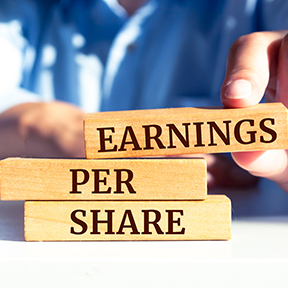X
Get started with TD EasyTrade™
Get started with TD Direct Investing

Earnings Per Share (EPS)
Earnings Per Share (EPS) is a measure commonly used by investors looking to make informed investment decisions. Simply put, EPS calculates how much money a company makes for every share of stock that it issues. While no single metric is perfect, EPS is widely used as a way to measure the value of a company and its stock.
This article will help investors understand EPS, how it is calculated, and its strengths and weakness as a financial metric. Most importantly, it will help investors understand how they can use EPS to make more informed investment decisions.
What is EPS?
EPS is a financial metric used by investors to estimate the value of a given company or its stock.
A company’s EPS is determined by dividing its net profit by the number of common shares it has outstanding. The higher the EPS, the more money a company has made on a per-share basis. The more money a company makes per share, the more attractive their shares may be to investors.
EPS is best used to monitor changes in the profitability of a company over time, or to compare the profitability of two or more companies within the same industry. EPS should always be assessed relative to a company’s stock price and used in combination with other financial metrics.
How to Calculate EPS?
EPS Formula
A company’s EPS is calculated by dividing its net profit by the number of common shares it has outstanding. Companies typically list EPS and diluted EPS on their income statement. While these two measures are similar, they include some important differences that investors need to be aware of.
Basic EPS
EPS = Net Profit – Preferred Dividends / End-of-Period Common Shares Outstanding.
A company’s net profit is determined by subtracting all cash and non-cash expenses for its revenue for a given reporting period. Preferred dividends are also subtracted to capture payments the company is obligated to make to preferred stockholders before making any additional payments to common stockholders.
Diluted EPS
Companies often use convertible debt to raise capital and offer employees stock options to provide additional incentives to workers. If lenders choose to convert their loans into stocks, and employees exercise their stock options, the company would be required to issue additional shares – thereby increasing the total number of shares outstanding.
Diluted EPS takes this into account and divides the company’s net profit by the number of shares currently existing, plus the number of additional shares the company may be obligated to issue in the future.
Diluted EPS = Net Profit – Preferred Dividends / End-of-Period Common Shares Outstanding + Diluted Shares.
In essence, diluted EPS acknowledges that a company issuing additional shares to address convertible debt or employee stock options would ‘dilute’ the per share value of a company’s stock. As a result, diluted EPS is often considered a more comprehensive metric and a better indicator of a company’s potential value. Because it uses a larger denominator, a company’s diluted EPS will usually be lower (and never higher) than a company’s basic EPS.
Basic EPS vs Diluted EPS
Difference in Calculation Method
EPS is used to determine how much money a company makes for each share of its stock. While EPS only considers the number of existing shares available, diluted EPS considers the total number of shares that could be available if convertible debt and employee stock options were exercised in the future.
The examples below will help you appreciate the difference in how EPS and diluted EPS are calculated and what they can tell you about a company’s value.
Examples
Company ABC had $12 million in net profit over the past year, paid out $2 million in dividends, and has 5 million common shares outstanding.
The resulting EPS for Company ABC is:
($12,000,000 - $2,000,000) / 5,000,000 = $2 per share
In addition to its 5 million shares outstanding, ABC employee stock options could be converted to 1 million additional common shares and its convertible debt could be converted to another 1 million common shares.
The resulting diluted EPS for Company ABC is thus:
($12,000,000 - $2,000,000) / (5,000,000 + 1,000,000 + 1,000,000) = $ 1.43 per share
Because Company ABC has dilutive securities in the form of employee stock options and convertible debt, its diluted EPS is less than its basic EPS.

Factors Affecting EPS
EPS is largely dependent on the number of shares a company has issued. If the total number of shares available goes up, the company’s EPS will typically go down. If the total number of shares available goes down, then the company’s EPS will typically go up. Other factors such as changes in revenue can also affect a company’s EPS.
Stock Buyback: Companies can decrease the number of common shares outstanding through stock buybacks. That’s when a company buys their own stock back from investors and cancels the shares that they repurchased. This reduces the total number of outstanding shares available and causes the company’s EPS to go up.
New Issuance: Companies can increase the number of common shares outstanding by issuing new shares. If a company issues new shares the number of outstanding shares will go up and the company’s EPS will go down.
Stock Split: Companies can also increase the number of shares available through stock splitting. Splitting stocks increases the total number of shares available and causes a company’s EPS to go down.
Company Revenue/ Profits: Increases in a company’s revenue or profits will increase its EPS, regardless of whether those increases are a result of increased sales, or a reduction in costs. The reverse is also true. A reduction in a company’s revenue and associated profits will typically cause its EPS to go down.
What Qualifies as a Good EPS?
There are no hard and fast rules when it comes to identifying a good or bad EPS. In fact, the specific value of a company’s EPS is often less important than how their EPS has changed over time or how it compares to the EPS of their competitors. EPS values can fluctuate significantly over the course of a given year. But steady gains in a company’s EPS year-over-year, and an increase in the rate of those gains, may be a good indication of the financial health of the company.
It’s also important to consider how a company’s EPS compares to investor’s expectations. A company’s stock price may go down, even if its EPS go up, if the increase in the company’s EPS is lower than expected. The opposite can also be true. A company’s stock price may go up, even if its EPS is declining, if that decline is less than what investors expected.
While EPS is an important indicator of a company’s value, it’s only one indicator. Other factors are also important considerations.
Limitations of EPS
While EPS is a commonly accepted metric, no metric is perfect. Limitations of EPS include:
-
EPS Manipulation: Companies can manipulate their EPS by increasing or decreasing the number of common shares outstanding. For example, a company can increase its EPS through stock buybacks or reduce its EPS by issuing additional shares or splitting stocks.
-
Changes to Accounting Policy: Changes in a company’s accounting policy can also change its EPS without any real change in a company’s profitability.
-
EPS does not Consider Share Price: A company’s EPS won’t give you any indication of whether a company’s stock is over or undervalued and currently trading above or below fair market value.
-
Company’s Net Profit does not Accurately Reflect Its Financial Health: Investors use a company’s net profit to calculate its EPS. But a company’s net profit isn’t always the best indicator of a company’s financial health. Net profit doesn’t reflect a company’s cash flow or the amount of debt that it owes. It can also be affected by tax and interest payments and other non-operating expenses which can vary significantly between businesses.
FAQs related to EPS
What is a good EPS and P/E Ratio?
There’s no definition of a “good” or “bad” EPS value. But all other things being equal, the higher a company’s EPS is, the better. The opposite is true for a company’s price-to-earnings (P/E) ratio. In most cases, the lower a company’s P/E ratio is, the better.
What does a higher EPS mean?
Companies with a high EPS may be more likely to have extra profits to pay out as dividends to shareholders. It’s also seen as an indication that the company is performing well. Stocks with a higher EPS may be more attractive to other investors than stocks with a lower EPS.
What should I know about EPS?
EPS is used to determine how much money a company makes for each share of its stock and is often used as an indicator of a company’s potential profitability. Typically, the higher the EPS, the more profitable a company is seen to be. That said, a lot of things can affect a company’s EPS. While EPS can be a good indicator that a company is profitable, it’s only one indicator and should be considered in combination with other metrics like share price and the company’s price-to-earnings ratio.
What does negative EPS mean?
A negative EPS is a sign that a company is spending more than its revenue and losing money.
What does it mean if EPS decreases?
A decreasing EPS can indicate a decline in the company’s profits. It may also be a sign that the company will be less likely to pay dividends to shareholders in the future.
Why is EPS important to investors?
Investors use EPS to determine how profitable investing in a company’s stock may be. While nothing is ever guaranteed, the higher a company’s EPS is, the more likely it is that the company will be profitable and be able to pay dividends to their shareholders.
Conclusion
EPS is widely used by investors to estimate the potential value of investing in a company’s stock.
A company’s EPS is especially meaningful when investors look at how a company’s EPS has changed over time and how it compares to the EPS of other companies within the same industry. EPS should always be considered along with other metrics. Understanding EPS, and how it is calculated, can help investors make more informed investment decisions.
Want to learn more about investing? Check out this article on how to invest your money.
Share this article
Related articles
View our learning centre to see how we're ready to help

